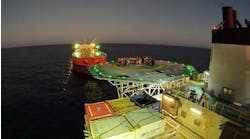Melbana identifies carbonate prospect offshore northern Australia
Offshore staff
SYDNEY, Australia — Melbana Energy has completed a review of hydrocarbon prospectivity in two license areas offshore Australia, WA-544-P and NT/P87 (Melbana 100%).
This has led to identification of a carbonate buildup within the license areas, which the company has named Hudson. Although isolated carbonate buildups contain some of the world’s largest oil reservoirs, the play type remains untested offshore Australia.
However, a first exploration well, Beehive-1, will test the play in the Beehive prospect in the adjacent WA-488-P license area, potentially next year. Melbana identified Beehive, and then it later sold the license to a US oil company in 2021.
In 2020 Melbana was awarded the two license areas under review, containing the undeveloped Turtle and Barnett oil discoveries, under the Australian government’s 2019 Offshore Petroleum Exploration Acreage Release.
Both are in shallow water (20m to 40 m) and about 300 km in the Northern Territory. The Blacktip gas field is to the northwest and its pipeline edges the northern boundary of NT/P87, providing potential export access to the Darwin LNG complex and/or Australia’s east coast gas market.
Melbana has reprocessed and reinterpreted the legacy 2D seismic data, allowing it to identify the new conceptual target within the Hudson platform. The two areas may host an early Paleozoic Carbonate platform sealed by evaporites.
Analogous formations in other parts of the globe include the Tengiz oil field onshore Kazakhstan as well as the Ungani oil and Raphael gas fields in Australia’s onshore Amadeus and Canning basins.
Melbana will seek to farm down some of its 100% interest in the license areas to fund acquisition of a 3D seismic survey to further de-risk Hudson.
07.05.2023



